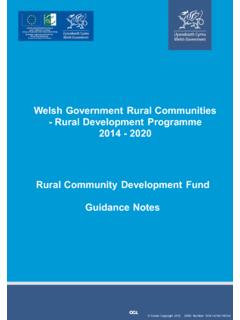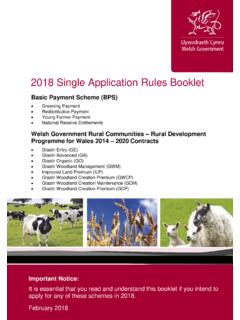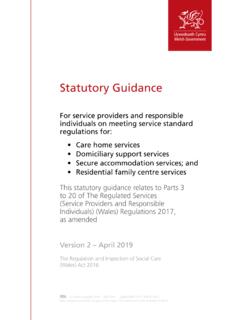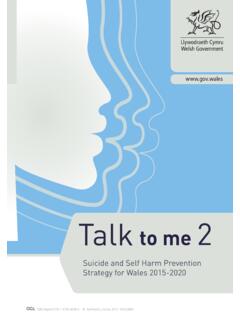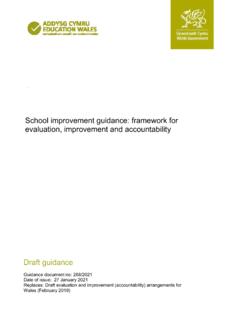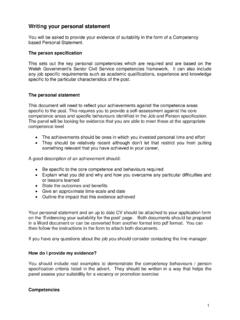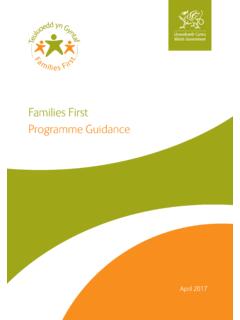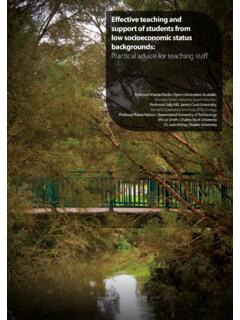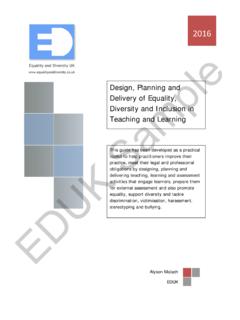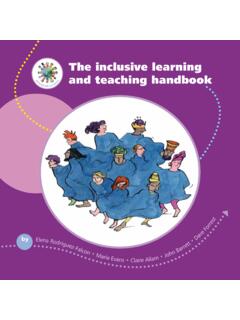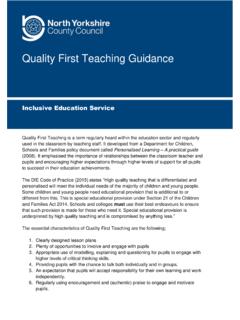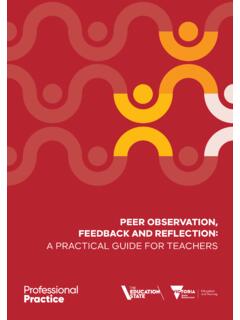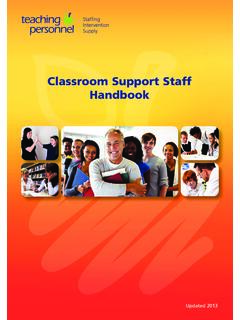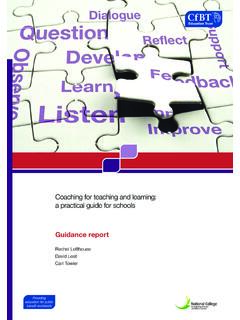Transcription of Practical Approaches to Behaviour Management in the ...
1 Practical Approaches to Behaviour Management in the classroomA handbook for classroom teachers in primary schoolsInformationInformation document no: 117/2012 Date of issue: July 2012 Digital ISBN: 978 0 7504 7411 5 Crown copyright 2012WG14682 Audience Headteachers and classroom teachers in primary This handbook is a resource to enhance the practice of teachers at primary level, primarily for newly qualified teachers (NQTs). This handbook focuses on general Behaviour Management methods and does not specifically cover issues relating to special educational needs (SEN).Action None for information only. requiredFurther Enquiries about this handbook should be directed to: information Pupil Wellbeing Team Department for Education and Skills Welsh Government Cathays Park Cardiff CF10 3NQ Tel: 029 2082 1556 Fax: 029 2080 1051 e-mail: Additional copies can be obtained from the contact details listed copies above.
2 This document can also be accessed from the Welsh Government s website at Behaving and Attending: Action Plan Responding to the documents National Behaviour and Attendance Review (2009) Inclusion and Pupil Support National Assembly for Wales Circular No: 47/2006 (2006) Safe and effective intervention use of reasonable force and searching for weapons (2010) Practical Approaches to Behaviour Management in the classroom1 Practical Approaches to Behaviour Management in the classroomContentsIntroduction 3 How to use this handbook 3 Understanding Behaviour 4 Effective classroom Management 7 Effective classroom Management 7 Positive relationships 11 The classroom 13 Whole-school Approaches 17 Well-evaluated Behaviour Management programmes 17 Getting to know your children 21 The teacher and the child 21 Knowing your children 23 Inappropriate Behaviour 25 The Foundation Phase 28 Dealing with specific classroom difficulties Practical solutions 32 The Antecedent- Behaviour -Consequence (ABC)
3 Chart 32 Preventing disruptive behaviours 34 Responding to challenging behaviours 35 Using reasonable force 36 Behaviour Management strategies 40Re-engaging individual children some Practical ideas 52 Monitoring and evaluating behavioural progress 52 More formal action 57 The use of nurture groups 60 Using sanctions effectively Practical ideas 65 Whole-school sanctions 65 teaching social skills 67 The link between bullying and children s Behaviour 72 Assessment and intervention 72 The link between children s non-attendance and Behaviour 78 Evidence from research 78 Playground Behaviour Practical ideas 84 Playtime 84 Buddy schemes 85 Games some Practical suggestions 89 Whole-class games 89 Developing behavioural skills 90 Tips for teachers Practical advice 92 You as the teacher 92 Remain in control 96 Annex: Example of a school s Behaviour policy Coed Eva Primary, Cwmbran 100 Bibliography 105 Further reading 1063 Practical Approaches to Behaviour Management in the classroomPromoting effective learning and teaching is paramount to the Welsh Government s agenda.
4 Key to achieving effective learning and teaching is ensuring that class teachers have the necessary skills to approach their teaching in ways that reduce the likelihood of children misbehaving. Teachers also need to be equipped with effective skills and responses for those instances where difficult Behaviour does occur. Where teachers have good preventative and responsive skills the likelihood of difficulties emerging or developing into incidents will be markedly reduced. This handbook is intended as a resource to enhance the practice of teachers at primary level, primarily for newly qualified teachers (NQTs), although others may also find something of interest in handbook focuses on general Behaviour Management methods and does not specifically cover issues relating to special educational needs (SEN).How to use this handbook Teachers may use the materials in different ways, depending on their role and their needs: as an interesting read to confirm their confidence in their own skills at managing Behaviour in the classroom as a resource pack that provides ideas and Approaches for addressing particular issues or difficulties as a resource for coaching or mentoring NQTs as a resource to help support other handbook focuses on the classroom level only.
5 Introduction4 Practical Approaches to Behaviour Management in the classroomUnderstanding the root cause of the child s Behaviour is essential, as without this it is unlikely that any Behaviour strategy will be sustainable. There are five basic models in understanding child Behaviour . These include: biological behavioural cognitive systemic have a tendency to interact with the environmental influences around them and this interaction informs their Behaviour . Research evidence has come from studies around twins separated at birth and early infancy. This goes to show that both nature and nurture are involved in our development, although when dealing with Behaviour attention needs to be paid to creating a positive environment and experiences to promote good can be modified through conditioning . This is achieved by another event following an action. There are two types of conditioning.
6 Classical conditioning a Behaviour is connected with a certain stimulus, for example a child feels happy and excited on a Friday afternoon as this is the time the whole class has Fun Friday . Operant conditioning a Behaviour is connected and repeated by rewarding the positive Behaviour and issuing sanctions for the negative cognitive approach helps the child judge and reason effectively and have a perception of their surroundings. This means that the way in which we behave is influenced by our behaviour5 Practical Approaches to Behaviour Management in the classroomThe cortex is the conscious, rational-thinking part of the brain and determines the child s response to certain situations. Research has shown that if an infant is constantly being subjected to negative situations, for example experiencing domestic violence and/or neglect, then the connections that form the cortex to help deal with situations in a rational way are limited.
7 In situations such as this the child is left to rely on the limbic system which is the body s alarm system. So when a child is faced with a mild situation, for example the person sitting next to them takes their pencil without asking, instead of the rational-thinking cortex being engaged the limbic system is triggered displaying the flight/fight systemic approach looks at targeting the individual s Behaviour within the system. These systems can include: their family their friends their school their classmates their community their outside school clubs, quality of these systems is a great influence on the child s Behaviour . For example, a child living in a family where domestic violence takes place will naturally struggle within another system, school. The Behaviour the child experiences at home, for example shouting, violence and/or aggressiveness, will not work in a school context which can cause problems for the child.
8 In situations such as this, working with the family to understand the environment in which the child lives is paramount in finding solutions to help their psychodynamic approach is one used in a clinical setting as it focuses on understanding and intervening by unravelling past conscious and unconscious experiences in order to help the child deal with Approaches to Behaviour Management in the classroomTips: Behaviour theory A child will repeat a Behaviour if it is being rewarded. A child will be less likely to repeat a Behaviour if sanctions are issued. If there is no consistency with rewards and sanctions then it is likely the child will continue to display the unwanted Behaviour . The more attention the teacher gives to a child s Behaviour the more likely it is that that Behaviour will be Approaches to Behaviour Management in the classroomEffective classroom managementIn order to create a positive learning culture within a school, effective interventions need to be implemented.
9 We will consider the following interventions: effective classroom Management positive relationships the Tips for teachers Practical advice section (pages 92 99) also sets out some Practical tips for teachers to help them with their personal classroom managementEffective Behaviour Management is based on the teacher s ability to successfully create a well-managed, structured classroom environment so that learning can occur. teaching a number of children with different needs, behaviours and attention spans can be challenging. However, when a positive learning culture is created, the children will learn better because they will know what is expected of classrooms: begin the year with a set of rules and routines which are understood by all children have agreed rewards and positive reinforcements have set sanctions for misbehaviour have a selection of options for dealing with disciplinary problems make use of their physical space have well-planned lessons encourage respect and develop positive : Behaviour theory A child will repeat a Behaviour if it is being rewarded.
10 A child will be less likely to repeat a Behaviour if sanctions are issued. If there is no consistency with rewards and sanctions then it is likely the child will continue to display the unwanted Behaviour . The more attention the teacher gives to a child s Behaviour the more likely it is that that Behaviour will be Approaches to Behaviour Management in the classroomRulesRules create clear expectations for the children and need to define what is acceptable Behaviour . These must be reinforced on a regular basis and placed in a visible place on the classroom wall. Include the children in developing the rules as this will give them ownership and they will be more likely to accept their terms and conditions and therefore help to minimise behavioural challenges in the classroom and are key to a well-managed and organised classroom. Children enjoy routines that are easy to understand and easy to accomplish, yet flexible enough to alter if circumstances change.

